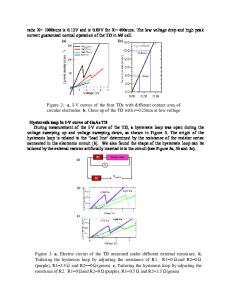Fabrication and Characterization of Nanofiber Enhanced Prepregs
- PDF / 335,577 Bytes
- 6 Pages / 432 x 648 pts Page_size
- 110 Downloads / 402 Views
Fabrication and Characterization of Nanofiber Enhanced Prepregs ABM Iftekharul Islam1, Ajit D. Kelkar1 1 Department of Nanoengineering, JSNN, North Carolina A&T State University 2907 E Gate City Blvd, Greensboro, NC-27401
ABSTRACT Typically, composites are lightweight, and high strength and hence are attractive for use in aerospace, automotive applications. For most of the aerospace applications, laminated composites serve as a primary load carrying structure and are subjected to a variety of loadings including transverse impact and fatigue loadings. The typical laminated composites are weak in the transverse direction. Since laminated composites are weak in the transverse direction, when these laminates are subjected to transverse loading, most of the time interlaminar failure occurs in the form of delaminations. Conventional methods of preventing delaminations include improving the design and improving the matrix properties. Although, improving the composite design suppress delaminations to some extent, a substantial amount of compromise with other properties like increase of resin volume fraction, degradation of inplane properties, voids, distortion in fibers and laminate, an increase of cost or process complexities are common. The present day researchers are more focused on improving matrix by nanomaterials such as Carbon Nano Tube(CNT), though the cost is hampering its potential for an industrial prospect. Electrospun nanofibers are being considered as a cheap alternative for vapor grown CNTs and other nanomaterials which involve complex fabrication and application methods in the field of interlaminar reinforcement for polymer matrix composites. Most of the aerospace quality composites are manufactured using prepreg due to the higher percentage of fiber volume fraction and hence higher mechanical properties. Although, nanomaterials have been recognized as a major advancement for improvement of composite material properties, there has been very little effort to fabricate prepregs using nanofibers. The current research focuses on the challenges involved in the fabrication of nanofiber enhanced prepregs and process difficulties and possible solutions for fabricating electrospun nanofiber overlaid prepregs. The effects of heat treatment on electrospun nanofiber overlaid woven fabric on the mechanical properties of both glass and carbon are investigated. A novel technique is proposed for manufacturing of nanofiber engineered prepregs. INTRODUCTION Delamination is a decade-long problem for composite structures. Delaminations can lead to catastrophic failures in composite structures. There are several ways delaminations in the composite structures can be mitigated. Some of these methods include: stitching [1], Z-pinning [2], 3-D composites [3], optimizing stacking sequence [4], Edge cap reinforcements [5], braiding [6], notched edge [7], critical ply terminations [8], discrete critical ply [9] method. Mignery et al. proposed [1] stitching for laminated composite structures to minimize the delamination possibilities.
Data Loading...











